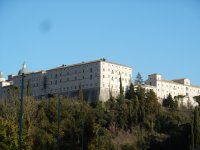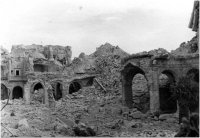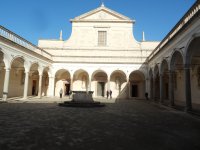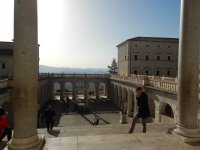Rebuilt from the rubble: Italy’s 6th century Montecassino Abbey
 A Sunday morning in February, I found myself in Cassino, a small city south of Rome at the edge of the Lazio region. This outing, like so many others of its kind, was for a running race of my youngest son.
A Sunday morning in February, I found myself in Cassino, a small city south of Rome at the edge of the Lazio region. This outing, like so many others of its kind, was for a running race of my youngest son.
It’s a pretty long trip from Rome to Cassino, but the February day was perfect and sunny, and after the race I was excited to finally have the opportunity to visit Montecassino – an ancient abbey dating back to the 6th century that I’ve long seen looming high above in the distance when traveling past it on the highway. This has been one of the many places I’ve always ‘meant to visit’.
 Ironically, my son’s passion for running does wonders for expanding my cultural horizons … especially since it has us constantly travelling around on weekends. : )
Ironically, my son’s passion for running does wonders for expanding my cultural horizons … especially since it has us constantly travelling around on weekends. : )
And so, when the race was over, my son and I wound our way up the curving drive to reach the abbey.
 For World War II history buffs, this will probably be a well-known name for you. Montecassino – unfortunately – was adjacent to the famous Gustav Line of defense. And that twist of fate led to its destruction.
For World War II history buffs, this will probably be a well-known name for you. Montecassino – unfortunately – was adjacent to the famous Gustav Line of defense. And that twist of fate led to its destruction.
 Both sides in the fierce fighting – the Germans and Americans – were under strict instructions that “all possible precautions be taken to avoid bombing the abbey on Monte Cassino due West of Cassino”.
Both sides in the fierce fighting – the Germans and Americans – were under strict instructions that “all possible precautions be taken to avoid bombing the abbey on Monte Cassino due West of Cassino”.
Sadly, as you can see from the accompanying photos, this did not happen.
 The fierce Allied-Axis fighting was not the first that the abbey, built under Saint Benedict in 529, endured.
The fierce Allied-Axis fighting was not the first that the abbey, built under Saint Benedict in 529, endured.
The abbey had been sacked by invading forces – both the Lombards in the sixth century and Saracens in the ninth century. It was rebuilt after an earthquake in the fourteenth century and again, following the sack of French troops in 1799.
 But 1944 seemed to toll the death knell for this spectacular abbey, of inestimable historical and artistic value. 1400 years of learning and instruction and art quickly crumbled under American bombing. Bombing that even the Generals at the time realized was futile and had served no military purpose. The abbey had mistakenly been identified as a command post for the Germans.
But 1944 seemed to toll the death knell for this spectacular abbey, of inestimable historical and artistic value. 1400 years of learning and instruction and art quickly crumbled under American bombing. Bombing that even the Generals at the time realized was futile and had served no military purpose. The abbey had mistakenly been identified as a command post for the Germans.
 For those of us who love languages, one historian claims the tragic error was caused by a junior British intelligence officer with less than stellar German language skills. The claim is that the confused the word ‘abbot’ with ‘battalion’, thereby misinterpreting a radio intercept to understand that a German battalion was amongst the monks at the abbey, rather than the more innocuous abbot amongst the monks.
For those of us who love languages, one historian claims the tragic error was caused by a junior British intelligence officer with less than stellar German language skills. The claim is that the confused the word ‘abbot’ with ‘battalion’, thereby misinterpreting a radio intercept to understand that a German battalion was amongst the monks at the abbey, rather than the more innocuous abbot amongst the monks.
 Luckily, many of the precious artworks and artifacts had been moved by the German army to the Vatican for safekeeping in the months before the bombing.
Luckily, many of the precious artworks and artifacts had been moved by the German army to the Vatican for safekeeping in the months before the bombing.
What you are visiting today on a visit is the reconstructed abbey. Rebuilding began after the war, carried out between 1950 and 1960 after an international appeal, and the new abbey was reconsecrated in 1964 by Pope Paul VI.
When you are travelling by Cassino, take time to visit this reconstructed abbey. I’ll return happily next time we have another race in the region.


Yeah languages sometimes connect people and sometimes not at all… 🙂
Very interesting… 🙂
Too true. Supposedly, the mistake was recognized pretty soon after it was made, but not soon enough to stop the bombs…
Weird question, but what race did your son do. I just rode by Friday on the way to Rome after 2 weeks in Italy. I could come back, run the race and visit. Thanks, George
A children’s race, I’m afraid. But you can always sign up for Rome’s marathon in March…